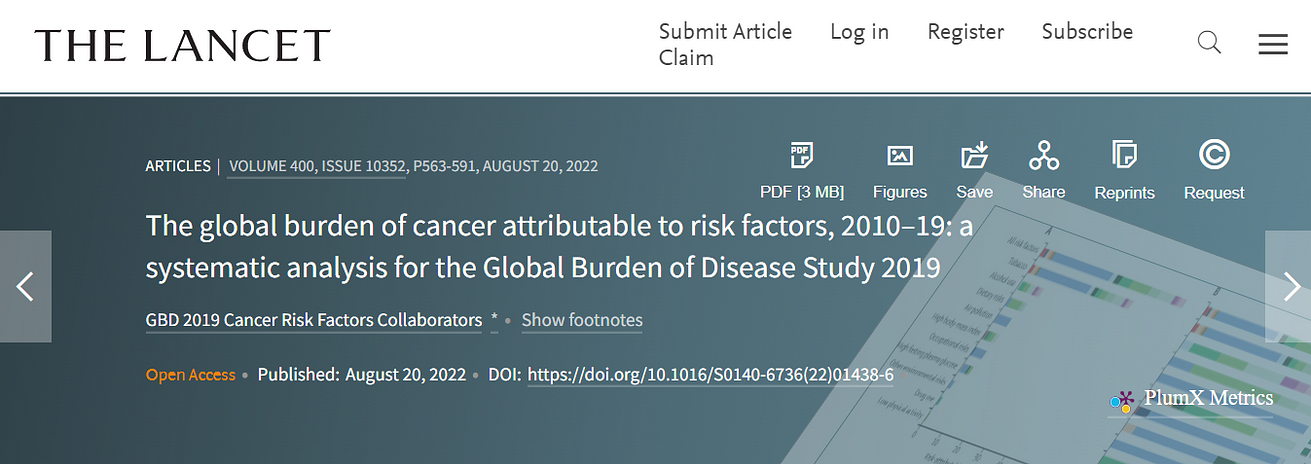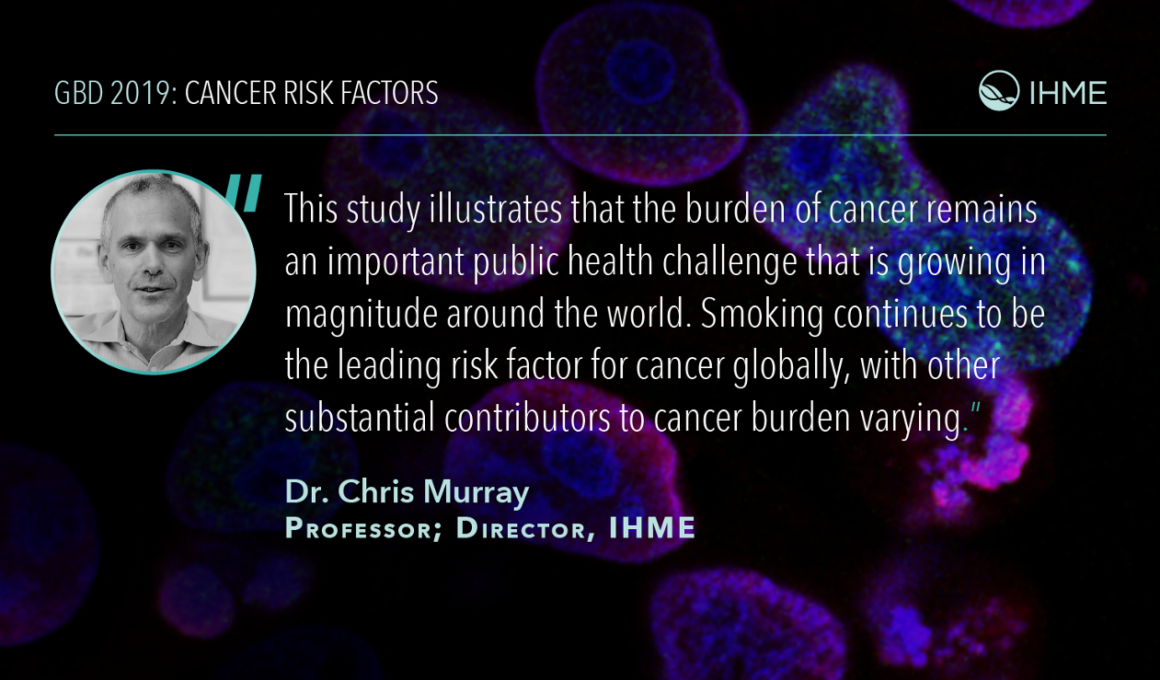Health Data
August 18, 2022
Site editor:
Joaquim Cardoso MSc.
health transformation . institute
cancer unit
August 23, 2022
Key points:
- Analysis of the impact of 34 risk factors on deaths and ill health from 23 cancer types suggests they accounted for 4.45 million cancer deaths globally in 2019 (44.4% of all cancer deaths) for both sexes combined, with smoking, alcohol use, and high body mass index (BMI) the leading causes.
- Half of all male cancer deaths in 2019 (50.6%, 2.88 million) were due to estimated risk factors, compared with over one-third of all female cancer deaths (36.3%, 1.58 million).
- Males had more years lost to death and disability due to environmental and occupational risks and behavioral risks compared to females.
- Global cancer deaths due to risk factors increased by an estimated 20.4% from 2010 to 2019 and differed considerably based on countries’ level of development.
- Authors call for investment in risk reduction strategies while strengthening health systems for early diagnosis and effective treatment.
Smoking, alcohol use, high BMI, and other known risk factors were responsible for nearly 4.45 million global cancer deaths in 2019, according to new research published in The Lancet using the Global Burden of Diseases, Injuries, and Risk Factors (GBD) 2019 study.
The new study is the first to estimate how a comprehensive list of risk factors contribute to cancer deaths and ill health globally, regionally, and nationally, across age groups, for both sexes, and over time.
Despite being the second leading cause of death worldwide after cardiovascular disease, to date most studies of cancer burden have analysed single risk factors globally or multiple risk factors in select countries.
“This study illustrates that the burden of cancer remains an important public health challenge that is growing in magnitude around the world. Smoking continues to be the leading risk factor for cancer globally, with other substantial contributors to cancer burden varying,” said Dr. Christopher Murray, Director of the Institute for Health Metrics and Evaluation (IHME) at the University of Washington’s School of Medicine and a co-senior author of the study.
“Our findings can help policymakers and researchers identify key risk factors that could be targeted in efforts to reduce deaths and ill health from cancer regionally, nationally, and globally.”
Using results from the GBD 2019 study [2], the authors investigated how 34 behavioral, metabolic, and environmental and occupational risk factors contributed to deaths and ill health due to 23 cancer types in 2019.
Changes in cancer burden between 2010 and 2019 due to risk factors were also assessed.
Estimates of cancer burden were based on mortality and disability-adjusted life years (DALYs), a measure of years of life lost to death and years lived with disability.
In addition to 4.45 million cancer deaths, which made up 44.4% of all cancer deaths in 2019, risk factors included in the analysis accounted for 105 million cancer DALYs globally for both sexes in 2019, 42.0% of all DALYs in that year.
Behavioral risk factors (such as tobacco use, alcohol use, unsafe sex, and dietary risks) were responsible for the vast majority of cancer burden globally, accounting for 3.7 million deaths and 87.8 million DALYs in 2019.
Almost 2.88 million deaths in men (50.6% of all male cancer deaths) could be attributed to the risk factors studied, compared to 1.58 million deaths in women (36.3% of all female cancer deaths).
The leading risk factors globally for cancer deaths and ill health for both sexes were smoking, followed by alcohol use and high BMI.
The leading cause of risk-attributable cancer death for both men and women globally was tracheal, bronchus, and lung cancer, which accounted for 36.9% of all cancer deaths attributable to risk factors.
- This was followed by colon and rectum cancer (13.3%),
- esophageal cancer (9.7%), and ]
- stomach cancer (6.6%) in men, and
- cervical cancer (17.9%),
- colon and rectum cancer (15.8%), and
- breast cancer (11%) in women.
Researchers found differences in men and women across two major categories: behavioral risks and environmental and occupational risks.
With behavioral risks, males (33.2%) had almost four times the cancer DALYs attributable to smoking than females (8.9%).
For alcohol use, males (7.4%) had more than three times the cancer DALYs than females (2.3%).
The higher cancer DALYs in males may be driven by men being more likely to smoke and drink than women.
When examining environmental and occupational risks, researchers found that the cancer attributable DALYs were three-fold higher among males (3.9%) than females (1.3%), suggesting that males may be more likely than females to work in places that have higher risk of being exposed to carcinogens.
Ill health attributed to environmental and occupational, behavioral, and metabolic risk factors increased with age, peaking in the 70s depending on countries’ Socio-demographic Index (SDI), with countries on the higher end of the spectrum tending to peak at later ages.
In 2019, cancer deaths (25.4%) and risk-attributable cancer deaths (26.5%) globally occurred disproportionately in high SDI countries, although these countries only accounted for 13.1% of the global population.
The five regions with the greatest cancer death rates due to risk factors were
- Central Europe (82.0 deaths per 100,000 population),
- East Asia (69.8 per 100,000),
- high-income North America (66.0 per 100,000),
- Southern Latin America (64.2 per 100,000), and
- Western Europe (63.8 per 100,000).
Patterns of cancer deaths and ill health due to environmental and occupational, behavioral, and metabolic risks differed around the world, with unsafe sex a leading risk factor for ill health in locations at the lower end of the SDI spectrum. Country-level data are available via online resources. [2]
Between 2010 and 2019, cancer deaths due to risk factors rose by 20.4% globally, increasing from 3.7 million to 4.45 million.
Ill health due to cancer increased by 16.8% over the same period, rising from 89.9 million to 105 million DALYs.
Metabolic risks accounted for the greatest percentage increase in cancer deaths and ill health, with deaths increasing by 34.7% (from 643,000 deaths in 2010 to 865,000 in 2019) and DALYs by 33.3% (from 14.6 million in 2010 to 19.4 million in 2019).
“Policy efforts to reduce exposure to cancer risk factors at the population level are important and should be part of comprehensive cancer control strategies that also support early diagnosis and effective treatment,” said Dr. Lisa Force, Assistant Professor in Health Metrics Sciences at IHME.
The authors acknowledge some limitations to their study that are mostly inherently in the data sources and knowledge available.
Due to a lack of data, there is greater uncertainty regarding estimates for lower SDI countries compared with higher SDI countries. Expanding data availability on risk factors and cancer burden is crucial to providing location-specific information and improving estimates. The risk factors included in the study are based on current knowledge, but as knowledge expands, additional risk factors may need to be included in future studies. Results from the GBD 2019 study were estimated prior to the COVID-19 pandemic, and therefore evaluating its impact on risk-attributable cancer burden is an important area for future research.
Writing in a linked Comment, Professor Diana Sarfati and Dr. Jason Gurney of the University of Otago, New Zealand, who were not involved in the study, say:
“The primary prevention of cancer through eradication or mitigation of modifiable risk factors is our best hope of reducing the future burden of cancer.
Reducing this burden will improve health and well-being, and alleviate the compounding effects on humans and the fiscal resourcing pressure within cancer services and the wider health sector.”
On links between cancer risk and poverty, they say: “It is no accident that behaviors associated with higher risk of cancer are patterned according to poverty, particularly within countries.
Poverty influences the environments in which people live, and those environments shape the lifestyle decisions that people are able to make.
Action to prevent cancer requires concerted effort within and outside the health sector.
This action includes specific policies focused on reducing exposure to cancer-causing risk factors, such as tobacco and alcohol, and access to vaccinations that prevent cancer-causing infections, including hepatitis B and HPV.”
“The primary prevention of cancer through eradication or mitigation of modifiable risk factors is our best hope of reducing the future burden of cancer.
Action to prevent cancer requires concerted effort within and outside the health sector.
This action includes specific policies focused on reducing exposure to cancer-causing risk factors, such as tobacco and alcohol, and access to vaccinations that prevent cancer-causing infections, including hepatitis B and HPV.”
NOTES TO EDITORS
This study was funded by the Bill & Melinda Gates Foundation. It was conducted by the GBD 2019 Cancer Risk Factors Collaborators.
Originally published at https://www.healthdata.org on August 17, 2022.
ORIGINAL PUBLICATION

Correspondence to: Prof Christopher J L Murray, Institute for Health Metrics and Evaluation, University of Washington, Seattle, WA 98195, USA
Dr. Lisa Force, Assistant Professor in Health Metrics Sciences at IHME.
Linked Comment, Professor Diana Sarfati and Dr. Jason Gurney of the University of Otago, New Zealand, who were not involved in the study,












